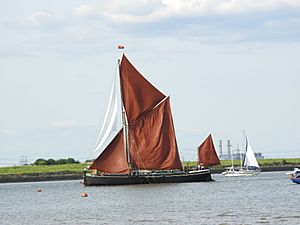SB Pudge facts for kids

Pudge on the Medway Estuary in 2017
|
|
Quick facts for kids History |
|
|---|---|
| Name | Pudge |
| Owner | Thames Sailing Barge Trust |
| Builder | London & Rochester Trading Co |
| Commissioned | 1922 |
| Status | Private use and private charter ship |
| General characteristics | |
| Tonnage | 97 |
| Length | 92.5 ft (28.2 m) |
| Beam | 22.5 ft (6.9 m) |
| Height | 0 ft (0 m) to top of mainmast |
| Draught | 3.5 ft (1.1 m) distance between the waterline and the bottom of the hull (keel) |
| Propulsion | Spritsail and Kelvin 66hp diesel |
| Notes | Pine on Oak |
SB Pudge is a special wooden boat called a Thames sailing barge. She was built in Rochester, Kent, England, in 1922. Her main body was made from strong pitch pine wood on an oak frame.
Pudge first had a type of sail called a spritsail rig, which helped her move. In 1932, a diesel engine was added to help her even more. She carried many different goods for the London & Rochester Trading Co until 1968. After that, the Thames Sailing Barge Trust bought her to preserve her history. Her very last cargo was pineapple juice!
Contents
The Story of Pudge
What are Thames Barges?
Imagine the big trucks we see today carrying goods. Long ago, Thames sailing barges were like those trucks for rivers! They could carry huge amounts of cargo, up to 150 tons at a time. These barges moved goods from outside London into the city.
They brought important things like coal for fires and bricks for building houses. They also carried hay for horses. Barges were even used to take rubbish out of cities. This rubbish was used as fuel in brick factories.
How Barges Sailed
These barges had a special type of sail called a spritsail rig. This rig was great for sailing on rivers and in tight spaces. It allowed them to catch steady winds even near tall buildings on the riverbanks.
Their flat bottoms were also very useful. They could sail over shallow parts of the river. They could also reach small creeks and higher parts of the rivers in the south east of England. Barges could even rest safely on a flat mud bank when the tide was out. Pudge carried all sorts of general goods, like grain and fertilizer.
Pudge's Early Days
By the 1880s, there were different kinds of sailing barges. Pudge was launched on February 15, 1895. She was built by John and Herbert Cann in Harwich. It's said she was built especially for a race, the 1899 Medway Barge Race. She won that race, finishing two and a half minutes ahead of another barge called SB Giralda.
Barges from Mistley, like Pudge, traveled to many places. They went to towns like Dunkirk, Calais, and Antwerp. They sailed from ports such as Dover, Rochester, and London.
Life Between the Wars
After World War I, Pudge continued her work along the coast. A skipper named Ephraim Cripps was her captain for 20 years. He kept records of every trip! From 1928 to 1930, Colchester was her main port. She worked along the coasts of Essex and Suffolk.
In 1933, she joined the fleet of Francis and Gilders Ltd. This company used her to move grain. She carried grain between Norfolk, Suffolk, and Essex, and into London.
Pudge in World War II
One of the biggest events for civilian ships in World War II was the Dunkirk evacuation. During this time, hundreds of small ships helped rescue soldiers. These soldiers were stuck on beaches in northern France.
Like many other sailing barges, Pudge was called into service in May 1940. She was in Tilbury and sailed to the meeting point at Dover. Under the cover of darkness, a tugboat named St. Fagan towed three barges: Pudge, Thyra, and Lady Rosebery. They were taken towards the beaches of Dunkirk.
Sadly, St Fagan was hit by a mine and sank. Lady Rosebery and Doris also sank. Pudge was lifted out of the water by the blast. But luckily, she landed the right way up! She took survivors on board and headed for England. Another tug, Tanga, helped tow her, and she arrived safely back at Ramsgate.
Rebuilding Pudge in 1988
Old wooden boats, especially those over 100 years old, need a lot of care. Their wooden planks and floors can become soft or rot. These parts can be replaced with new pitch pine planks. However, some parts of the frame are hidden. These need to be uncovered and checked for damage.
If the front or back of the boat starts to droop, it means the frame has a problem. This often points to rot. When a commercial barge was full of cargo, it sat lower in the water. The water helped support the boat's structure. But a barge carrying passengers would face different stresses. Pudge started showing these signs of wear.
When parts of her outer layers were removed, many of her inner timbers were found to be cracked or broken. These were strong oak timbers, some as long as 35 feet! The damage was likely caused by two collisions, a sinking, getting stuck, and the explosion at Dunkirk. Different types of wood had to be used for the repairs. This was because the original kind of timber was no longer available.
See also

